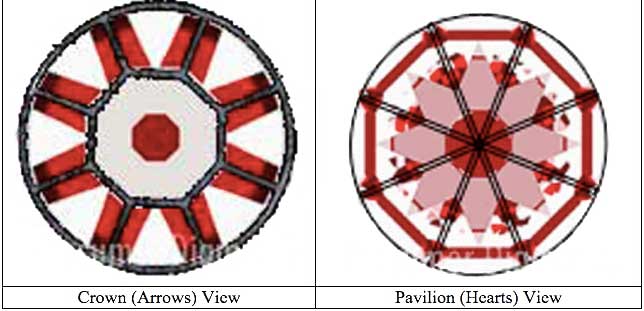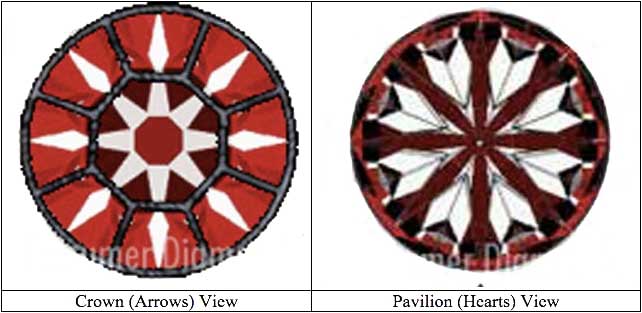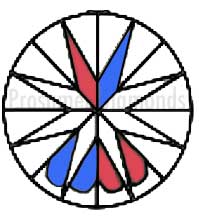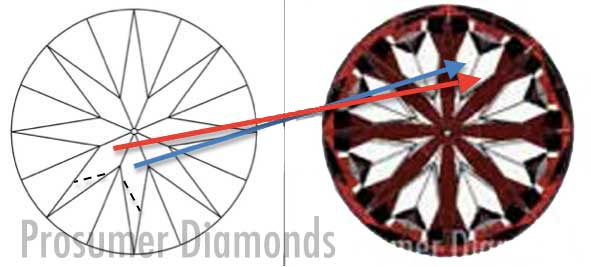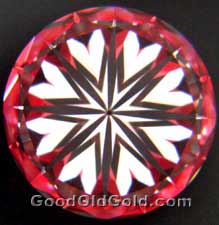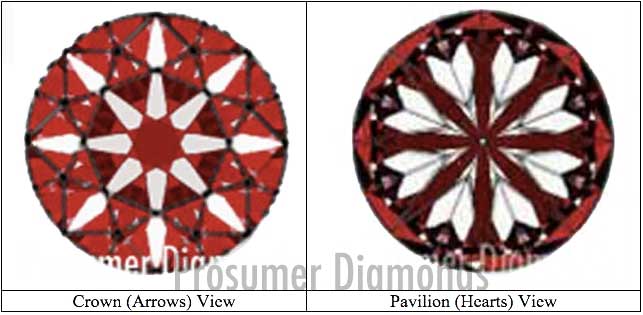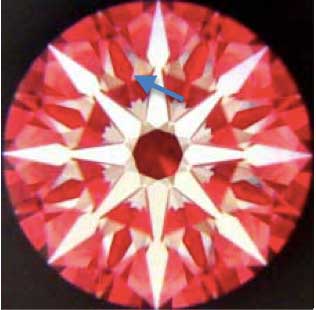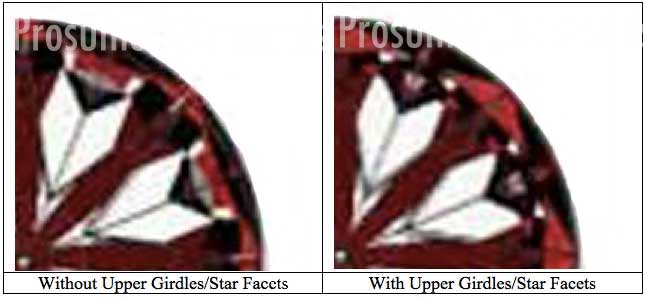Crown and Pavilion Facets
The images above are what the hearts and arrows images would look like for a single or ‘eight’ cut diamond – that is with only the crown, pavilion, table, girdle, and culet formed. The wire mesh shows the faceting of the eight crowns and eight pavilions. The arrows image is taken from the crown view and the hearts image is taken from the pavilion view. An H&A viewer returns white from the top and shades of red from the sides; light leakage is black. The shades of red are not important because we are not looking at light performance.
In the crown view, you can easily see through the table into the pavilion facets that are returning light from overhead. You can also see the table reflection in red. The white triangles that you see are reflections of part of the pavilion facet from the opposite side of the diamond, which are inverted. The red areas on the sides of the crowns are returning light from the side of the diamond.
In the pavilion view, the real pavilion facets are more or less acting as the crowns would, and are returning light from the side of the diamond so they are in red. You can see the reflections of the pavilion facets on the opposite sides of the diamond; again they are inverted but they are red because the the pavilion facets are angled and meet at a point, the culet.
Adding the Lower Girdles
The images above are the hearts and arrows images after the lower girdles are added. You can see that it is the lower girdles that primarily create the hearts and arrows effect by shaping the arrows. The arrows image is actually made up of the reflections of opposing pavilion facets. The arrow head is formed because the crown facet provides a different view of the pavilion reflection.
More interesting is how the hearts are formed.
It takes two pavilion mains together to make up a single heart. The image above demonstrates the formation of the 6:00 heart.
Take a closer look at a single side of a heart; it is actually the reflection of the pavilion facet as seen from that lower girdle. You can also see that the real lower girdle facets split the hearts from the Vs. This explains why shorter lower girdles produce hearts that are closer to the Vs. Lower girdles that are shorter than 75% will have hearts that touch the Vs and are a cause for rejection for H&A purists.
(This image is courtesy of Good Old Gold, used with permission.)
Lengthening the lower girdles has the opposite effect of a wider gap between the heart and the V. If the lower girdle length is above 78.5%, then there will begin to be clefts in between the hearts because the reflections of the pavilion mains are also more angled in towards each other. The existence of clefts are also a cause for rejection for H&A purists. You can see how the popoularisation of H&A has helped precision diamond cutters because it limits the lower girdles to a narrow range between 75 to 78.5%. To put it in perspective, the variance in the lower girdle angle for a range between 75 to 78.5% lower girdle length is less than one degree.
Star and Upper Girdle Facets
The images above show the typical H&A images you see in a full-cut round brilliant diamond with a wire mesh showing the real facets. You can see how the brillianteering of the upper girdle and star facets changes the shape of the table.
(This image is courtesy of Good Old Gold, used with permission.)
The reflection of the lower girdle seen through the stars is actually quite similar to the arrows that the reflections of the pavilion mains seen through the crown, just reversed. Hopefully you can now spot for yourself that the hotspots are simply reflections of the pavilion mains adjacent to the lower girdle reflection seen through the stars. You also can see how lengthening the stars reveal more of the lower girdle and pavilion main reflections leading to larger hotspots. The M’s that can be seen in the crowns and the upper girdles are actually the many virtual facet reflections of the lower girdles/pavilion facets.
On the hearts image, the star facets are responsible for flattening out the tips of the hearts and finally adding the upper girdles round off the edges of the table reflection (off the crown facets) and complete the patterning of the H&A image.
Conclusion
You should now have a much better understanding of how a hearts image can help you identify the minor defects in a diamond. Misaligned arrows mean that opposing pavilions are not symmetrical. Hearts that are not symmetrical means there is asymmetry in the pavilion mains. Misaligned hearts and distorted V’s indicate that there is some misalignment of the lower girdles. A cleft in between the hearts and the gap between the heart and the V can help determine the length of the lower girdles. We now know that basically all the hotspots are simply reflections of the pavilion mains and all the M’s are reflections of the lower girdles. We also know that any variation in the width of the tips of the hearts indicate variation in the star facets, and any imbalance in the edges of the hearts image indicates variation in the upper girdles.
